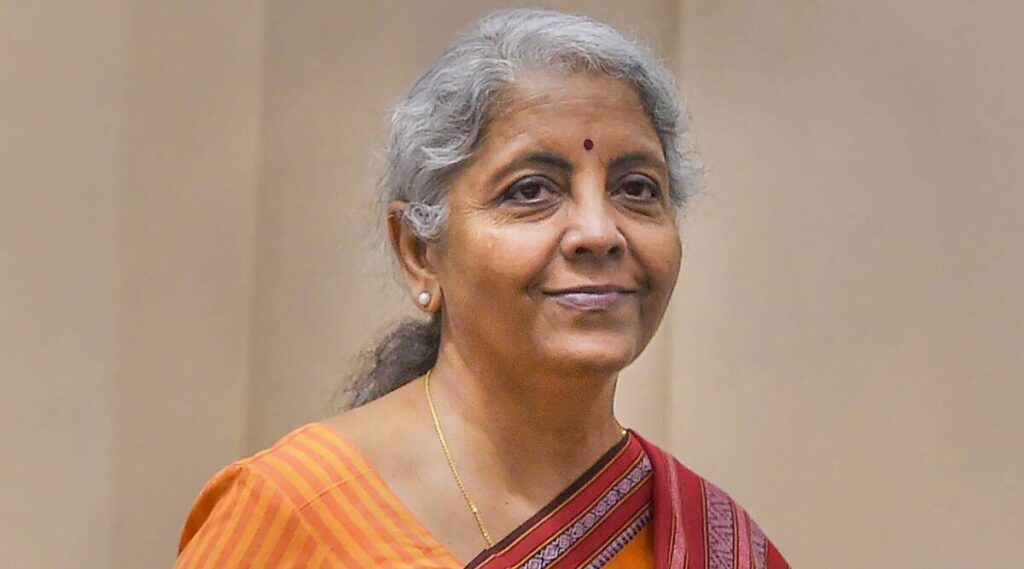Sitharaman said Rs 1.4 lakh crore is the “rough bottom line” now for GST collections.
GROSS GOODS and Services Tax (GST) collections rose 55.8% year-on-year to Rs 1,44,616 crore for June (for sales in May), the second highest level since the July 2017 rollout of the indirect tax regime, according to data released by the Finance Ministry. Economic recovery, anti-evasion activities, especially action against fake billers, along with the impact of inflation have contributed to the rise in GST.
Before this, GST collections had recorded the highest-ever level of Rs 1.68 lakh crore in April for year-end sales in March. This is the fifth time that monthly collections have crossed Rs 1.40 lakh crore since inception of GST, and the fourth month in a row since March 2022. GST collections in June 2021 stood at Rs 92,800 crore.
Speaking at the GST Day celebrations on Friday, Union Finance Minister Nirmala Sitharaman said that within five years of its rollout, GST was showing its potential. “The gross GST revenue collection for the month of June is Rs 1,44,616 crore, 56% rise from the same month last year. So the trend that was being talked about,we are now reversing that and showing that GST revenues remain above Rs 1.40 lakh crore. So, Rs 1.40 lakh crore is the rough bottom line, we are not going below that. We will remain above that,” she said.
She also said that the Central Board of Indirect Taxes and Customs (CBIC) is open to suggestions from industry, and the tax arbitrage that existed between states before GST rollout has been removed. “GST has removed discretion to a large extent, there is no way for rent seeking…. But I would still say we should be performing better in terms of removing even one little iota of discretion. If it is there, we should just make sure that the system is so transparent, that the whisper of allegation of discretion somewhere should be completely removed,” she said.
The higher GST revenue growth is expected to ease revenue concerns for some states going ahead, but states with a heavy dependence on compensation may find FY23 to be a challenging year, experts said.
As per the GST (Compensation to States) Act, 2017, the states were guaranteed compensation at the compounded rate of 14%, from 2015-16 as the base year, for losses due to implementation of the regime, for five years of its rollout. This came to an end on June 30. The GST Council meeting held earlier this week did not take any decision on extending the compensation mechanism, despite demands from at least a dozen states.
June also saw the highest-ever collection of compensation cess, at Rs 11,018 crore, since the implementation of GST. “The collection in June 2022 is not only the second highest but has also broken the trend of being a low collection month as observed in the past…coupled with economic recovery, anti-evasion activities, especially action against fake billers, have been contributing to the enhanced GST. The gross cess collection in this month is the highest since the introduction of GST,” said the Finance Ministry statement.
The total number of e-way bills generated in May was 7.3 crore; it was 7.4 crore in April.
The average monthly gross GST collection for the first quarter of 2022-23 was Rs 1.51 lakh crore, against the average monthly collection of Rs 1.10 lakh crore in the same period last fiscal. In June, revenue from import of goods was 55% higher and revenue from domestic transactions (including import of services) was 56% higher, as compared to last year.
Barring Daman & Diu and Centre jurisdiction, which recorded a contraction, all other states/ UTs recorded double-digit growth in GST generated, with Tamil Nadu, Maharashtra, Haryana and Uttarakhand leading.
Experts said action against tax evaders, including efforts in audits and analytics, will help boost the GST collections beyond the budgeted figures.
“This implies a substantive upside of around Rs 1.2 trillion to the Government of India relative to its FY2023 Budget Estimates for CGST (Central GST) of Rs 6.6 trillion. The sharp YoY growth of 56% in headline GST revenues in June 2022 benefits from the economic recovery, and has also been boosted by the low base of the second wave of Covid-19 and the transmission of elevated commodity prices into output inflation. If GST collections grow at the envisioned pace of around 17% in FY2023, then many states may be able to withstand the end of the GST compensation period. However, some states with a relatively higher dependence on GST compensation within their revenue sources, may find FY2023 to be a particularly challenging year,” said ICRA’s Chief Economist Aditi Nayar.
Abhishek Jain, Partner Indirect Tax, KPMG in India, said, “These consistent high collections indicate recovery from the pandemic hit and can also be attributed to inflation and tight checks and balances implemented by the government. The collections should give some comfort to both the Centre and states on the revenue front.”

Source:indianexpress.com

